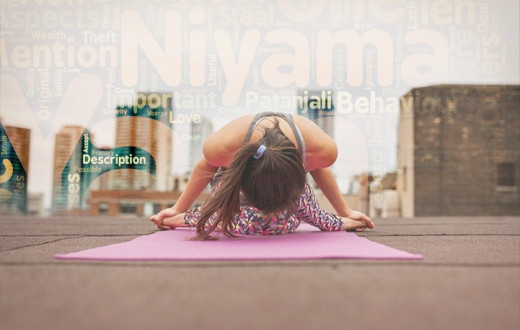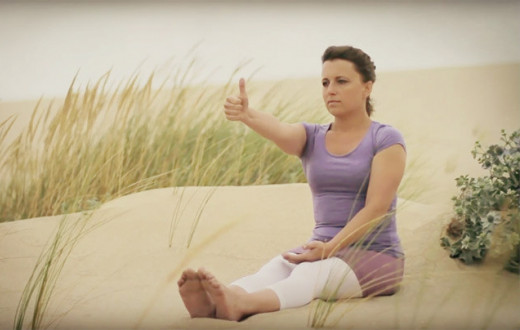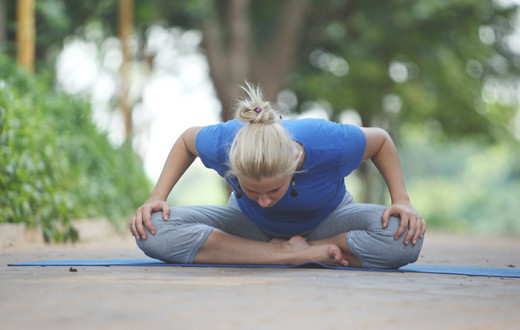In late 2016, news articles about 98-year-old yoga instructor Täo Porchon-Lynch hit the interweb, stunning the world with videos and photographs of the senior yoga teacher’s body twisted into yoga postures that many 20-year-old’s only dream of achieving. Her secret? Ms. Porchon-Lynch has been waking up at 5 am and teaching yoga for the past 75 years! So maybe the secret to youth is not botox and firming cream…
Ms. Porchon-Lynch is a testament to the power that regular yoga practice has in slowing down the aging process. While certain factors, such as genetics and environment, can indeed influence aging, our daily practices and lifestyle decisions, such as practicing yoga, can overpower potential genetic and environmental health threats. And one of the best ways to maintain health, as Ms. Porchon-Lynch demonstrates, is with regular exercise and yoga. In fact, yoga is one of the best options for seniors, as it is a low-impact exercise that can be modified to accommodate physical limitations. Yoga asanas tone the body, keep the hormonal system in balance, and refresh the mind and spirit, all of which allow the body to age with grace.
1. Can seniors (above 65 years) do yoga asanas?
As Täo Porchon-Lynch proves, YES! However, unlike Ms. Porchon-Lynch, you do not have to be a 75-year yogi to practice yoga as a senior. At the core of yoga is a union of various aspects of our existence - including the body, breath, and mind. In fact, the word yoga comes from the Sanskrit root 'Yuj', which means 'to unite'. It is, therefore, possible for people of all ages to utilize the power of yoga for creating a harmonious and joyful existence. Chair yoga for seniors is increasingly popular and is an excellent way to maintain physical strength if standing for long periods causes pain or fatigue.
2. What kind of asanas are best for seniors?
If you are easily fatigued, it is best to substitute warm-ups for walking and gentle joint movements, such as wrist and ankle rotations.
Standing yoga postures such as Triangle Pose (konasana series) and Standing Spinal Twist (Kati chakrasanas) are great for seniors who are comfortable standing, as are sitting yoga postures such as Butterfly Pose, Cradling (if possible), Body Rotation, Cat Stretch, and Child Pose (Shishu Asana).
Yoga postures done while lying on the back or stomach, such as Cobra Pose (Bhujangasana), Locust Pose (Shalabhasana) or Knee to Chin Press (Pawanmuktasana) can help to strengthen the back and increase flexibility in the spine.
Yoga Nidra, or Savasana (Corpse Pose), is by far the most essential part of any yoga practice, and with age, the pose becomes even more essential to help assimilate the effects of yoga practice into the body.
3. Are there any simple and easy yoga poses for seniors?
Sukshma Yoga is a practice that uses small motions to open up the subtle energy channels in the body. Sukshma Yoga techniques are incredibly simple and easy and lead to deep relaxation. People of every age can practice and receive the benefits of these exercises, which can be practiced alone or within a larger sequence. The routine includes gentle exercises for the eyes, tongue, jaw, neck, hands, feet, knees, ankles, and hips. Check out Sukshma Yoga Exercises to Relax You in 7 Minutes.
4. How should seniors practice yoga asanas?
The Patanjali Yoga Sutras define Asana as "sthira sukham asanam," which translates into “that which is stable and comfortable is an asana.” In layman’s terms, any posture held with awareness in a stable and comfortable manner constitutes an asana. So don’t worry - twisting yourself into a pretzel is not the only way to practice yoga! As long as you move with awareness of your breath, body, and mind, you are practicing yoga.
5. What is a “correct” yoga practice?
The best way to gauge “correctness” is by checking your inner compass. Do as much as you can, and remember to smile! If you feel comfortable and can smile, you are doing it right! Discomfort, pain, and unhappiness indicate an incorrect practice.
6. How does yoga for seniors differ from yoga for younger people?
Täo Porchon-Lynch is a shining example of the way in which the terms “old” and “young” refer to the state of the body, rather than numerical age. In fact, many older adults have greater flexibility than sedentary young people. In general, though, cardio-heavy flow practices and asanas that require abdominal strength can be more challenging for seniors, as can holding postures for long periods of time.
7. Do Yoga Asanas increase the efficiency of the immune system for the elderly?
Here, again, the Patanjali Yoga Sutras provide us with insight. Sutra 2.16 states "heyam dukham anaagatam,” which translates into “so that we can avoid the misery that has not yet come.” As we age, the efficiency of our bodies and the immune system’s defenses deteriorate, increasing the risk of sickness. Regular practice of yoga for seniors can lower stress hormones and inflammation, boost the immune system, and decrease the chance of sickness.
So whether you are 65 or 105, lay down your yoga mat, grab a chair, and get started with your yoga practice today!
While a regular yoga practice can result in improved health, know that it is not a substitute for medical treatment. It is important to learn and practice yoga under the supervision of a trained teacher. In the case of a medical condition, practice yoga after consulting a doctor. Do you need information on courses? Contact us at programs@us.artofliving.org to find a Sri Sri Yoga course at an Art of Living Center near you.
We would also like to invite you to attend a free breath and meditation online session to learn about SKY Breath Meditation, the perfect accompaniment to any yoga practice.





























